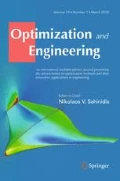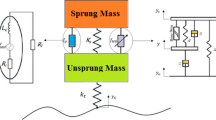Abstract
The development of a methodology that enables the optimization of passive suspension system parameters, providing a group of optimal solutions, could be an excellent approach to obtain a fast improvement tool during the design of suspension systems. Thus, this paper proposes a methodology for the multi-objective optimization of the passive suspension system of a full-car model travelling in a random road profile. For this purpose, a numerical-computational routine is developed, which integrates the NSGA-II with the vertical dynamic analysis, in the time domain, of an eight degrees-of-freedom vehicle model with a seat. Three objective functions, which take into account passenger comfort and safety, are considered. The proposed methodology provides a Pareto-optimal front, which consists of a set of non-dominated solutions that minimize the three objective functions. Comparing the results of the dynamic analyses of the vehicle model with optimized and non-optimized suspension systems, it was verified that the optimization allowed a reduction of up to 21.14% of the weighted RMS value of the driver seat vertical acceleration, a parameter directly related to comfort, while maintaining or improving the trade-off with safety. The Pareto-optimal front has proven to be an excellent support tool to aid the designer in the determination of the parameters that best fit the suspension system to produce the desired dynamic behavior in vehicles. Thus, the proposed optimization methodology can be recommended as an effective tool for the optimal design of passive suspension system parameters. Finally, this work shows that the design of suspension parameters can be done taking into account passenger comfort and safety at same time.







Similar content being viewed by others
References
Abbas W, Emam A, Badran S, Shebl M, Abouelatta O (2013) Optimal seat and suspension design for a half-car with driver model using genetic algorithm. Lect Notes Control Inf 4(2):199–205
Bianchi L, Dorigo M, Gambardella LM, Gutjahr WJ (2009) A survey on metaheuristics for stochastic combinatorial optimization. Nat Comput 8:239–287
Braun H (1991) Meßergebnisse von straßenunebenheiten, VDI-Berichte 877, Düsseldorf, Germany
Deb K, Pratap A, Agarwal S, Meyarivan T (2002) A fast and elitist multiobjective genetic algorithm: NSGA-II. IEEE Trans Evolut Comput 6(2):182–197
Dodds CJ, Robson JD (1973) The description of road surface roughness. J Sound Vib 31(2):175–183
Drehmer LRC, Casas WJP, Gomes HM (2015) Parameters optimisation of a vehicle suspension system using a particle swarm optimisation algorithm. Veh Syst Dyn 53:449–474
Eberhart R, Kennedy J (1995) A new optimizer using particle swarm theory. In: Proceedings of the international symposium on micro machine and human science, Nagoya, Japan, 4–6 Oct
Fadel Miguel LF, Lopez RH, Miguel LFF (2013) Multimodal size, shape, and topology optimisation of truss structures using the Firefly algorithm. Adv Eng Softw 56:23–37. https://doi.org/10.1016/j.advengsoft.2012.11.006
Florea A, Cofaru II, Roman L, Cofaru N (2016) Applying the multi-objective optimization techniques in the design of suspension systems. J Digit Inf Manag 14(6):351–367
Gadhvi B, Savsani V, Patel V (2016) Multi-objective optimization of vehicle passive suspension system using NSGA-II, SPEA2 and PESA-II. Procedia Technol 23:361–368
Gandomi AH, Talatahari S, Tadbiri F, Alavi AH (2013) Krill herd algorithm for optimum design of truss structures. Int J Bio-Inspired Comput 5(5):281–288. https://doi.org/10.1504/ijbic.2013.057191
Geem ZW, Kim JH, Loganathan GV (2001) A new heuristic optimization: harmony search. Simulation 76:60–68
Gillespie TD (2010) Fundamentals of vehicle dynamics. Society of Automotive Engineers, Warrendale
Gobbi M (2013) A k, k − ε optimality selection based multi objective genetic algorithm with applications to vehicle engineering. Optim Eng 14:345–360
Gobbi M, Mastinu G (2001) Analytical description and optimization of the dynamic behaviour of passively suspended road vehicles. J Sound Vib 245(3):457–481
Gobbi M, Levi F, Mastinu G (2006) Multi-objective stochastic optimisation of the suspension system of road vehicles. J Sound Vib 298(4–5):1055–1072
Gobbi M, Guarneri P, Scala L, Scotti L (2014) A local approximation based multi-objective optimization algorithm with applications. Optim Eng 15:619–641
Griffin MJ (1990) Handbook of human vibration. Elsevier Academic Press, London
Guclu R (2005) Fuzzy logic control of seat vibrations of a non-linear full vehicle model. Nonlinear Dyn 40:21–34
Guo P, Zhang JH (2017) Numerical model and multi-objective optimization analysis of vehicle vibration. J Zhejiang Univ-Sci A 18(5):393–412
Holland JH (1975) Adaptation in natural and artificial systems. The University of Michigan Press, Ann Arbor
International Organization for Standardization, ISO 2631-1 (1997) Mechanical vibration and shock—evaluation of human exposure to whole-body vibration, Switzerland
International Organization for Standardization, ISO 8608 (2016) Mechanical vibration—road surface profiles reporting of measured data, Switzerland
Jamali A, Shams H, Fasihozaman M (2014) Pareto multi-objective optimum design of vehicle-suspension system under random road excitations. Proc Inst Mech Eng Part K J Multi-body Dyn 228(3):282–293
Khalkhali A, Sarmadi M, Yousefi S (2017) Reliability-based robust multi-objective optimization of a 5-DOF vehicle vibration model subjected to random road profiles. J Cent South Univ 24(1):104–113
Meng R, Xie NG, Wang L (2014) Multiobjective game method based on self-adaptative space division of design variables and its application to vehicle suspension. Math Probl Eng. https://doi.org/10.1155/2014/479272
Miguel LFF, Fadel Miguel LF (2012) Shape and size optimization of truss structures considering dynamic constraints through modern metaheuristic algorithms. Expert Syst Appl 39:9458–9467. https://doi.org/10.1016/j.eswa.2012.02.113
Moradi A, Nafchi AM, Ghanbarzadeh A, Soodmand E (2011) Optimization of linear and nonlinear full vehicle model for improving ride comfort vs. road holding with the Bees Algorithm. In: Proceedings of the IEEE colloquium on humanities, science and engineering research, Penang, Malaysia, 5–6 Dec
Nagarkar MP, Patil GJV, Patil RNZ (2016) Optimization of nonlinear quarter car suspension seat-driver model. J Adv Res 7(6):991–1007
Nariman-Zadeh N, Salehpour M, Jamali A, Haghgoo E (2010) Pareto optimization of a five-degree of freedom vehicle vibration model using a multi-objective uniform-diversity genetic algorithm (MUGA). Eng Appl Artif Intel 23(4):543–551
Naudé AF, Snyman JA (2003a) Optimization of road vehicle passive suspension systems. Part 1. optimization algorithm and vehicle model. Appl Math Model 27:249–261
Naudé AF, Snyman JA (2003b) Optimization of road vehicle passive suspension systems. Part 2. qualification and case study. Appl Math Model 27:263–274
Ngwangwa HM, Heyns PS, Breytenbach HGA, Els PS (2014) Reconstruction of road defects and road roughness classification. J Terramech 53:1–18
Sekulic D, Dedovic V, Rusov S, Salinic S, Obradovic A (2013) Analysis of vibration effects on the comfort of intercity bus users by oscillatory model with ten degrees of freedom. Appl Math Model 37:8629–8644
Shinozuka M, Jan CM (1972) Digital simulation of random process and its applications. J Sound Vib 25:111–118
Shirahatt A (2015) Analysis and simulation of active suspension system for full vehicle model subjected to random road profile. Int J Innov Res Sci Eng Technol 4(1):18489–18502
Shirahatt A, Prasad PSS, Panzade P, Kulkarni MM (2008) Optimal design of passenger car suspension for ride and road holding. J Braz Soc Mech Sci 30(1):66–76
Shojaeefard MH, Khalkhali A, Erfani PS (2014) Multiobjective suspension optimization of a 5-DOF vehicle vibration model excited by random road profile. Int J Adv Des Manuf Technol 7(1):1–7
Song C, Zhao Y, Wang L, Niu L (2014) Multi-objective optimization design of passive suspension parameters based on competition-cooperation game model. Aust J Mech Eng 12(1):13–24
Wang L, Xie NG, Song CZ, Bao JH, Cen YW (2010) Multi-objective bionics design method of passive suspension parameters based on hybrid behavior game. Struct Multidiscip Opt 42(3):371–386
Xie NG, Meng R, Ye Y, Wang L, Cen YW (2013) Multiobjective design method based on evolution game and its application for suspension. Struct Multidiscip Opt 47(2):207–220
Yang XS (2010) Firefly algorithm, stochastic test functions and design optimization. Int J Bio-Inspired Comput 2(2):78–84
Yang XS, Deb S (2010) Engineering optimization by cuckoo search. Int J Math Model Numer Optim 1:330–343
Acknowledgements
The authors acknowledge the financial support of the funding agencies CNPq and CAPES from Brazil.
Author information
Authors and Affiliations
Corresponding author
Rights and permissions
About this article
Cite this article
Fossati, G.G., Miguel, L.F.F. & Casas, W.J.P. Multi-objective optimization of the suspension system parameters of a full vehicle model. Optim Eng 20, 151–177 (2019). https://doi.org/10.1007/s11081-018-9403-8
Received:
Revised:
Accepted:
Published:
Issue Date:
DOI: https://doi.org/10.1007/s11081-018-9403-8




